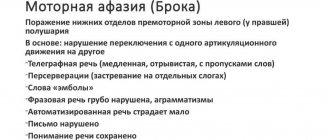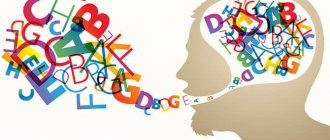Compiled by: member of the Association of Neurorehabilitation Doctors of Russia, speech therapist - aphasiologist of the first category, Department of Rehabilitation Medicine - Early Neurorehabilitation of the Republican Clinical Hospital named after G.G. Kuvatova, Ufa Fatkullina L.K.
Read the beginning of the methodological manual in the article “Manual for speech therapists. Part 1. Requirements for conducting a neuropsychological study"
Methodological basis for the diagnosis and correction of speech disorders in the work of a speech therapist with adults
Main types of speech disorders
There are two main forms of disorders - aphasia and dysarthria (the first is more common). With aphasia, there is a deterioration in speech functions as a result of damage to the speech centers in the brain. It can be complete (when speech is completely absent) and partial. The first time after a stroke is often accompanied by a lack of speech, but thanks to high-quality rehabilitation measures the situation improves.
There are six main forms of aphasia:
1. Motor. It is divided into two main types - afferent and efferent. In the case of the first, a person experiences difficulties in choosing the articulatory posture necessary to pronounce specific sounds. With efferent speech, instinctive speech is preserved, but repetition is severely impaired. Patients are bothered by kinetic apraxia, which makes it impossible to switch from one position to another.
2. Dynamic. The main characteristic speech defect is severe difficulty or inability to actively speak. The patient is unable to formulate a statement normally because external and internal speech is impaired. Echopraxia often appears when a person automatically repeats his interlocutor’s words and movements.
3. Touch. It is divided into three main types: cortical, subcortical and transcortical. In the first case, the patient does not understand or pronounce sounds. In the second case, the transmission of impulses from the centers that perceive sound information is distorted. With the third, the ability to perceive light speech structures is preserved, but writing is impaired and visual function deteriorates.
4. Semantic. Patients have a complete lack of understanding of complex speech formulations that reflect spatial relationships. Difficulties often arise in completing tasks containing complex syntactic structures. Patients are able to forget the names of familiar objects (for example, spoons, tables). Reading is slow, acalculia may develop. This is a neuropsychological symptom that manifests itself as a counting disorder
5. Acoustic-mnestic. This form is characterized by difficulties associated with retaining in memory information perceived by a person by ear. Many patients are not even able to repeat after a speech therapist a simple sequence consisting of 3-5 words, or to grasp the meaning of speech at a fast pace or when talking with two or more people at once.
6. Total. This form is characterized by a complete absence of speech (due to damage to many speech areas of the brain). This is the most severe form, which requires long-term correction with drug therapy and exercises.
Dysarthria is a speech disorder associated with impaired mobility of the organs of articulation (tongue, palate and lips). It can develop when various structures are affected, but most often the cranial nerves involved in the functioning of the speech muscles are affected. Dysarthria consists of difficulty pronouncing certain words or sounds (speech is sluggish and slurred).
What kind of illness is there?
The main characteristic of motor aphasia is a violation of oral speech (incorrect grammatical structure of sentences, difficulties with articulation, repetition of words and phrases) with preserved understanding of spoken speech.
There are two forms of motor aphasia: afferent (kinesthetic) and efferent, or Broca's. The form of aphasia describes the characteristics of speech disorders. The same patient may experience one type of disease or several at once, depending on which structures of the cerebral cortex are affected. In such cases they speak of a combined form. Motor aphasia can also be combined with sensory aphasia, then they speak of a sensorimotor form.
The depth of speech dysfunction reflects the degree of the disease. They depend on the amount of damage and how successfully neural connections are restored. There are four degrees:
- mild motor aphasia, the child can, in principle, speak, but more slowly than usual, the vocabulary is reduced,
- with a moderate degree, speech is significantly impoverished, the child finds it difficult to speak, he simplifies phrases as much as possible, and does not use prepositions;
- with severe motor aphasia, the baby prefers to communicate using facial expressions and gestures, uses little speech, and constructs phrases incorrectly;
- total, or complex motor aphasia of severe severity, is the complete disappearance of speech.
In children, in most cases, the condition progresses from more severe phases to lighter ones, and often to complete recovery.
Restoring speech after a stroke: a set of exercises
Speech restoration after a stroke is prescribed in conjunction with other measures (for example, drug therapy, physiotherapy and massage). Develop a plan on an individual basis. Often it includes a special complex consisting of breathing and articulation exercises, which patients need to perform in the inpatient department under the strict guidance of a speech therapist.
Due to the fact that speech disorders can come in different forms and degrees of severity, the specialist selects the exact set of exercises individually for each patient. Exercises can also be performed at home after discharge from the inpatient department.
Early speech rehabilitation begins immediately after the patient’s condition is stabilized in the inpatient department. First, the speech therapist conducts a full examination. Testing allows you to detect all problems associated with pronunciation, understanding, reading, writing, articulation. For this purpose, special tests are performed (additionally, a consultation with a neurologist may be required).
Ways to eliminate speech disorders
Restoration of speech function occurs in several stages. The duration directly depends on the severity of the clinical case: some functions can be preserved, while others are completely or partially impaired.
Exercises on understanding other people's and one's own speech are important. To do this, they practice clarification of spatial representations, construct the specified standards, and sort words according to their meaning. Good results are obtained from exercises related to the construction of statements using reference words that have spatial meaning. In complicated conditions, they resort to improvisation on a specific topic, interpretation of words and expressions that are difficult in meaning.
The next step is to correct the pronunciation and restore normal articulation. Special work is being carried out with tempo, intonation and speech patterns. Poems and sayings are often used. At the end, you need to restore your reading and writing skills. To do this, they conduct training with the names of letters and numbers, practice reading techniques and analyze the text read.
At the first stage, the speech therapist carries out work, which may include the following practices:
1. Use of alternative questions. The doctor specifically poses the question in such a way that the person does not have the opportunity to answer with a normal gesture. For example, the question: “Do you like fruit drinks?” doesn't fit. Suitable wording: “Do you like fruit drink or tea? What would you like to drink now?
2. Listing of items. A person looks at cards with different objects on them. The task is to name them. With the help of such cards, the patient is asked to choose the correct name from several possible options.
3. Use of photographs of close relatives of the patient. Doctors often use images in their practice so that people can recognize familiar faces from them.
4. Answers using words from the question. Sometimes experts ask patients to answer questions by repeating words in a different order.
5. Pronouncing letters and numbers. The patient looks at randomly arranged letters and numbers (their size and number directly depend on the severity of the clinical case) and tries to pronounce them.
6. Exercises on series of numbers. Often a person is unable to name familiar series (for example, days of the week). Therefore, for practice, they suggest playing the rows backwards (for example, counting from 3 to 13 and back).
7. Reading. When the patient has retained reading skills, it is recommended to use them to speed up the rehabilitation period. To do this, he is given simple tasks: slowly pronounce out loud individual words, parts from the text.
At the second stage, when the person’s condition is normalized and previous practices are easy, the speech therapist offers more complicated tasks. First of all, it is necessary to normalize the connection between word and image, to develop the ability to easily retain speech structures. A person must learn to construct phrases on his own. To do this, the doctor shows various pictures, and the person says what exactly is shown in them. After this, they are asked to match a specific picture to a word and vice versa.
Additionally, they practice working with plot pictures and entire cycles of pictures in chronological order. The patient is asked to write a short story with a certain number of words. Work is underway with the tempo and intonation of statements. Often, the doctor asks the patient to retell text of varying levels of complexity using supporting words and images. At the end, to consolidate the result, they are asked to write a short story under dictation.
Exercises on understanding other people's and one's own speech are important. To do this, they practice clarification of spatial representations, construct the specified standards, and sort words according to their meaning. Good results are obtained from exercises related to the construction of statements using reference words that have spatial meaning. In complicated conditions, they resort to improvisation on a specific topic, interpretation of words and expressions that are difficult in meaning.
The next step of the second stage is correcting the pronunciation and restoring normal articulation. Special work is being carried out with tempo, intonation and speech patterns. Poems and sayings are often used. At the end, you need to restore your reading and writing skills. To do this, they conduct training with the names of letters and numbers, practice reading techniques and analyze the text read.
Breath control
An individual set of exercises is developed by a specialist. Below is one example. First of all, you need to take a comfortable horizontal position. Your hands should be folded in front of you, in the abdominal area, in order to feel and control abdominal breathing well. Next, take a deep breath through the nose and slowly exhale through the mouth. This breathing technique is repeated several times, after which it is complicated by adding the following sounds while exhaling:
· long [f];
· long [w];
· long [s];
· long [x].
The number of required repetitions will be determined by a specialist.
Speech therapy exercises
In addition to breathing control, it is important to perform a set of exercises to develop the muscles of the tongue. It may include different exercises. For example, sticking out the tongue while holding it down the midline for several counts or moving it first to the right and then to the left cheek for 10 seconds.
By doing exercises regularly, progress will not be long in coming. However, it is important to understand that the patient requires psychological support to recover. Therefore, comprehensive work is recommended so that during classes a speech therapist and a relative are present nearby, who has been taught all the nuances.
Along with speech disorders, motor, psychological and cognitive disorders are often observed, so they additionally resort to other methods. Among them: physiotherapy, physical therapy, massage, drug therapy.
Advantages of visiting the Yusupov Hospital
The Yusupov Hospital provides its patients with a full range of medical services, including inpatient treatment, examination, surgery and rehabilitation. Diagnostic procedures of any level of complexity are provided. Services are provided in various medical areas. One of the priorities is neurology. A team of experienced specialists works with each patient after a stroke. They conduct diagnostics and begin rehabilitation as soon as possible. This helps the patient regain interest in life, activity and independence in everyday life.
During rehabilitation, speech therapy exercises are practiced to restore speech after a stroke. An individual approach is provided to each patient, which guarantees positive dynamics in treatment. It is possible to stay with relatives in a family ward, with a nurse.
To make an initial appointment with a specialist, call the numbers listed on the website or fill out a standard form online, leaving contact information for feedback.
Symptoms
Afferent aphasia is accompanied by the occurrence of a number of symptoms and syndromes, which form the clinical picture characteristic of this form. Expressive language impairment syndrome includes:
- Violation of spatial movements, such as facial expressions and gestures, as well as a complete absence of situational speech process. When trying to repeat sounds, the patient makes only isolated movements with his lips and tongue;
- Speech becomes overly clichéd, there are syllable and sound dropouts.
The patient also experiences pronounced difficulties in pronouncing complex syllables, namely: they divide words into parts and skip the most complex sounds. There is a violation of the understanding of someone else's speech, however, this period does not last long from a day to several days and occurs after suffering an acute cerebrovascular accident.
The victim’s spatial disorientation, as well as impairment of writing and perception of visual text information, are also noteworthy. When writing, the patient shifts vowels, omits consonants, and changes the order of letters.
Prevention of afferent and efferent motor aphasia
There is no specific prevention for the development of aphasia. All preventive measures are primarily aimed at eliminating risk factors that increase the risk of vascular diseases. Since acute cerebrovascular accident is the most common cause of aphasia, stroke prevention has an indirect effect on the development of aphasia.
Timely treatment of arterial hypertension, correction of the blood lipid profile, as well as annual preventive examinations will help to avoid extensive brain damage.
As with any other disease, prevention implies:
- Maintaining a healthy lifestyle;
- Proper nutrition;
- Normalization of the work-rest regime;
- Rejection of bad habits.
Diagnostics
The diagnostic search is aimed at identifying the underlying disease or cause that served as the impetus for the development of motor afferent aphasia. The diagnostic plan includes a standard set of studies. The first step is to collect an anamnesis of the disease, after which a topical diagnosis is carried out to determine the expected extent of damage to brain tissue, then a preliminary diagnosis is made.
To clarify it, a number of instrumental studies are carried out, such as:
- Magnetic resonance imaging of the brain, and contrast can also be used to improve brain imaging characteristics. Magnetic resonance imaging allows you to identify oncological lesions, the presence and volume of a hematoma in traumatic brain injury;
- Angiography of cerebral arteries for the presence or absence of vascular pathology;
- Ultrasound Doppler examination of neck vessels;
- Lumbar puncture if there is suspicion of encephalitis, meningitis or leukoencephalitis;
- Electroencephalography to exclude pathology of an epileptiform nature or oncological lesions of the brain.
The Clinical Brain Institute is focused on studying, diagnosing and treating patients with neurological symptoms, including patients with motor aphasia. The Clinical Institute of the Brain operates a powerful and modern diagnostic department, which makes it possible to make correct diagnoses with a high degree of probability.






